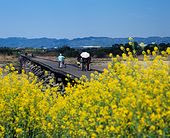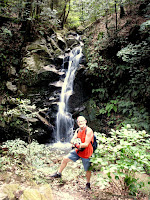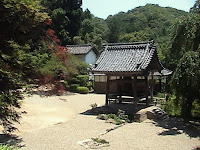 |
| Ujitawara. |
So, what is a "no plan - getting lost" trip? Quite simply, it's where I choose a destination (that's the only plan), make a bee-line for that destination then, upon arrival, find a thoroughfare (of any shape-or-size) and go from there. Up to now I have never got lost on one of these trips, unlike a planned outing when I am almost guaranteed to get lost. They are awesome. I never know what to expect and, on all the occasions I have done one of these trips, I have returned and, in many cases, added to my created course.
On this occasion I chose the Jubu-san road that borders the towns of Wazuka and Ujitawara. I have traveled this road many times - both on foot and bike - and have descended some of the many tracks that take one through a variety of environments - tea-plantations, rice-fields, dense forest, picturesque-secluded settlements - to reach the bottom.
 |
| Map Location. |
This Video is an introduction to the Jubu-san road and the junction (I will attach a link, at the conclusion of this post, of the descent and emergence from the forest. As-well-as other videos) .
 |
| Linden Baum - cafe & restaurant. Map Location. |
15-minutes and 4.5km later, after a descent of 384m, I emerged into the settlement of Shimonoto, on the rural-outskirts of Ujitawara, and my first "discovery" of the day - the Linden Baum Cafe & Restaurant. Tucked-away amongst this little community one could have quite-easily missed this (the only reason I found it was because I wanted to record a video of the area).
An obscure-overgrown track, that disappeared into the bushy-hillside, lured me to my next destination but, after some searching, I decided to give-it-a-miss and u-turned back to the village.
About 1km down the road I arrived at a junction, in front of me I could make out a busy road (it was route-307), so I took the lane to my right and headed back into the hills via the village Yuyadani. These thoroughfares are so narrow they must be hell to navigate in a truck/bus. This lane soon petered-out and emerged into a clearing where a junction, comprising of six tracks, converged. In front of me was a noticeboard with a map of all the hiking trails in the area (further on, at my next stop,I found maps of these trails) but, not wanting to venture too far from home, I u-turned and took another track back in the direction I had just come from. After passing-by a tea-plantation, I was soon confronted by two men who's car had got stuck in the mud (check this video out) and was obliged to assist. After several failed attempts, a third man offered to get his small truck and tow them.
 |
| Chasomyo-jinja. |
 |
| Birthplace of Nagatani Soen. |
Emerging from the forest I was soon to happen-across my next "discovery" of the day. This site came as a shock to me and I decided to rest-up, have a bite-to-eat, and check-out the surroundings. The Shrine, looking many hundreds-of-years old (in fact it was erected in 1954), is used to enshrine the spirit of Nagatani Soen who developed the tea-processing method which involves steaming, kneading and drying, and is still used today. As I passed-through the Shrine complex, I noticed signs informing me of a hiking course in the area. Upon return home, and some map research, I discovered the track finishes at the same area where I first commenced this course (needless-to-say, it has been placed on my "must do" list). Across the lane from the Shrine is the birthplace of Nagatani Soen and today is used to preserve the Hoiro (equipment used to roast and dry tea-leaves over a fire).
After lunch, which consisted of a sultana-malt loaf and some sticky chocolate donuts, and washed-down with a hot coffee, I was back on my seat and another secluded track. Exiting the settlement of Yuyadani, and back towards route-307, a narrow lane up into the hills caught my attention, and I was off to explore more of Ujitawara.
 |
| Map Location. |
 |
| Map Location. |
By now I am nearing route-307, and the commercial area of Ujitawara and the completion of this outing. But, there was one more wee find that nearly made me to come in collision with a car.
 |
| Map Location. |
A hundred metres down the road from the Inari Shrine, was the Sannomiya-jinja, which was where I decided to bring this fantastic journey to an end. As I had seen & experienced so much during the past 4.5-hours, I was eager to get home (an hours cycle from here), upload my videos and photos and search the internet for any relevant information to include in with this post. And what a lot there was too. I will definitely be returning to the Ujitawara area to add to this course - I am already planning to hike the trail from Chasomyo-jinja to Kontai-ji, and hope to do it in the next week.
So, from Ujitawara, thanks for reading and watch-out for more from my files of "No Plan - Getting-Lost" outings.
Videos from today's outing: Tea Plantation, Jubu-zan Road Ujitawara.
Descent from Jubu-zan Road.
Emergence from mountain into Shimonoto.





































































